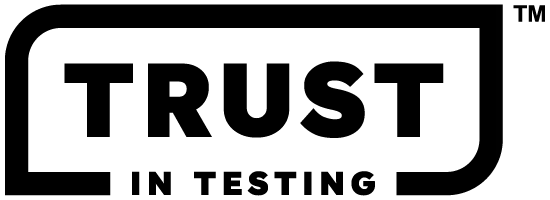I'm a lab, how can I join?
For details on how to become a Trust in Testing Certified lab, contact the Trust in Testing Oversight Committee at trustintesting@sclabs.com or trustintesting@actlab.com.
I’m a brand, how can I join?
To receive the Trust in Testing seal, brands must commit to using a Trust in Testing certified lab. Currently, SC Labs and ACT Lab are the only two labs that have employed the rigorous testing guidelines, including more frequent and regular proficiency testing, use of state-of-the-art quality management systems, and internal employee ethics and training programs.
For more details on how to become a Trust in Testing Certified Brand, please reach out directly to SC Labs (CA, OR, CO, MI, AZ) at trustintesting@sclabs.com, or directly to ACT Lab (MI, IL, PA, OH, NY) at info@actlab.com.
How are brands allowed to use the Trust in Testing trustmark?
First, brands are required to attest that the Trust in Testing Certified seal will only be applied to products tested by a Trust in Testing Certified Lab. All production batches of that product must be tested in order to use or continue to use the trustmark. It may also be used on the product page, COA of that certified product.
Brands are responsible for ensuring all labeling and packaging with the use of the Trust in Testing Certified seal is in compliance with State regulations.
How does Trust in Testing monitor compliance?
In cooperation with the Oversight Committee, both SC Labs and ACT Lab utilize various tools including Artificial Intelligence to monitor the use of the trustmark. From time to time concerned consumers will inquire about the validity of the mark on a product. The Oversight Committee then investigates to confirm or deny the authenticity of the mark. Inappropriate use of the mark will result in legal action and the organization will seek damages for these trademark violations.
What is the specific criteria? What are the SOPs required?
The criteria in which the labs abide by can be found on the Trust in Testing website at trustintesting.org. A detailed description of the criteria to be applied for each of the attributes is currently being written and will be available soon.
How were these criteria and SOPs selected for this program?
The selection of the attributes for the program was based on several factors and controls that are in place in other related industries such as OTC, foods, consumer products, and pharmaceuticals. After discussing with regulators, best practices were created based on our past testing experience in these industries as well as identified gaps in the cannabis industry.
Which tests are included in the Trust in Testing certification?
The Trust in Testing Certification includes all required potency and contaminant tests for the state in which the product was produced. Contaminants include, but are not limited to, heavy metals, pesticides, residual solvents as well as microbial contaminants such as aspergillus, E. coli, and salmonella. Cannabinoids and terpenes are those included in potency testing.
Is the Trust in Testing Certification approved by regulators?
The Trust in Testing certification goes above and beyond what cannabis regulators require in any given state. By requiring adherence to tighter controls on potency and contaminant testing, brands that are certified have voluntarily put their products under a greater level of scrutiny, all to provide a greater level of transparency and safety to the consumer.
How did SC Labs and ACT Lab come together to create this program? Why are these two labs qualified to lead this program over other MSO Labs in the US?
ACT Lab and SC Labs believe that “what’s on the label should be in the package” and are jointly taking a stand for consumer safety by outlining the most stringent lab quality requirements to ensure brands and consumers can trust their lab testing data. The initiative will help cannabis brands build consumer loyalty, maintain investor and customer confidence, and, ultimately, provide safer products to the growing cannabis market.

